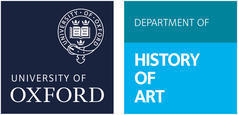Reflection: An Internship at the Ashmolean’s Eastern Art Department
Reflection: An Internship at the Ashmolean’s Eastern Art Department
By Phebe McManamon, Third Year BA History of Art, March 2023
Before Michaelmas 2021 I had only a general knowledge of Indian art, from the few objects studied in my high school art history class. I had signed up for ‘Encountering South Asian Sculpture’ because of this— and because the course summary mentioned hands-on experience with artifacts, a prospect I couldn’t pass up. In addition, I was assigned to the Ashmolean’s Eastern Art Department for my collections placement. Between classes, essays, and tutorials, I spent one afternoon a week in the museum archives, studying a colonial-era institution I had barely heard of before.
Our first-year coursework touched on the development of two Oxford museums: the Ashmolean, for art, and the Pitt Rivers, for ethnography. One that was largely absent from our studies was the University’s Indian Institute, run by the Boden Professor of Sanskrit from 1883 to 1962. After its closing, the objects were dispersed, and its Broad Street building was repurposed as the Oxford Martin School– you can still see elephants and tigers on the facade today. My work in the Eastern Art Department deals with the Institute’s historical archives, digitizing them for easier access by both Ashmolean staff and university members.
I was able to spend one academic term studying the Indian Institute and its effect on Oxford museums today— and then looking through the archives, tracking its development behind the scenes. Most of the correspondence follows the same script: someone writing about an object, and asking if the Institute would like to buy it from them. Some letters identify the artifact’s origin, style, historical period, or the figures depicted; others have only a vague description. Most convey some personal connection to, or appreciation of, the artwork and general Indian culture. However, several letters mention that if the Institute does not wish to acquire the object, then the staff should dispose of it entirely. The contrast between their enthusiastic description and a total disregard for the artwork is jarring, and speaks to the treatment of South Asian art at the time, placed within the Eurocentric narrative as primitive and classical, ‘fine art’ and ‘non-art’.
In class we discussed the Indian Institute’s function not just to educate the public, but also to train future colonial officers. In one of the last letters I read before the summer holidays, it is possible that I found the very moment this dual purpose came to life. Professor Edward Johnston, the Keeper of the Institute, and Sir Lancelot Graham were discussing the ‘unsatisfactory state’ of the collection in spring 1939. One suggestion Johnston offers is to cater to I.C.S. probationers who will eventually work in the British Raj: ‘...I find that they take a great interest in the Museum and that it stimulates their interest in, and knowledge of, India. Once an official arrives in India he has few opportunities of obtaining a general view of the history of Indian civilisation, and consequently many officers never learn to take an interest in it. If, however, this interest can be aroused before the beginning of their active service, I think they would, for the most part, continue to develop their knowledge of it after arrival in the country.’ Johnston’s assumption that Indians cannot properly explain or exhibit their culture to Europeans is shocking, but reveals their condescending views toward the people whose culture they were putting on display.
One notable correspondence was between Johnston and a man named Govind Charan. Like the other letters, it concerns a possible acquisition. Unlike the other letters, it references specific Indians by name. Unlike the anonymous ‘helpers’ seen in photos of archaeological digs, these two letters give credit to those who were involved in the discovery, research, and preservation of South Asian art. Charan is an ‘authorised dealer of antiquities,’ as well as the licensed agent of the Muttra Museum. He offers 10 stone and 18 terracotta antiquities from his personal collection, with the caveat that their display in the Institute be credited to him. The letter then takes an unexpected turn: ‘It will not be out of place to mention here that I am the nephew of the Late Rai Bahadur Pt. Radha Krishna of Muttra, who was the life and soul of this famous Museum of India.’ He describes his uncle as an archaeologist with a large antiquities collection, which he has inherited. These ‘possible acquisition’ letters usually follow one of two patterns: negotiations with other British museums, or with individual British collectors. To read correspondence with people from India (not white Britons from the Raj) is highly unusual. Charan’s letter asserts himself in the market of South Asian antiquities, both from his family connections and on his own merits. He even signs his name in Hindi, rather than English, at the end of his letter. It is therefore disappointing to read Johnston’s response. He agrees that the acquisition ‘should attract connoisseurs in England to your collection, and I will give any enquirers your address.’ But he makes no mention of Charan’s uncle and his legacy– not his archaeology career, his surviving collection, or his work in the Muttra Museum. I can only hope that Charan will reappear in the archives this coming year.
At the beginning of Michaelmas, it seemed to me that an internship placement so similar to my coursework would be a drawback. Instead, the overlap between them has deepened my understanding of both South Asian sculpture and the realities of museum work. I have been able to relate it to seemingly unrelated classes, such as imperial collections in Court Culture & Art, or museums’ colonial legacies in American Art: Hispanic Voices. I’m sure I will make connections in my Special Subject, Art and the Invention of Race. And as I return to the archives this fall, I’m hoping I will find even more correspondence from people like Govind Charan, who were attempting to make a space for themselves within an inherently colonial institution.





